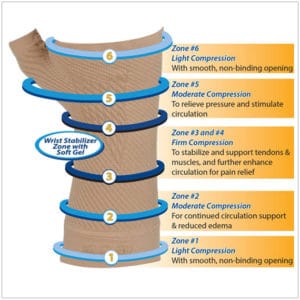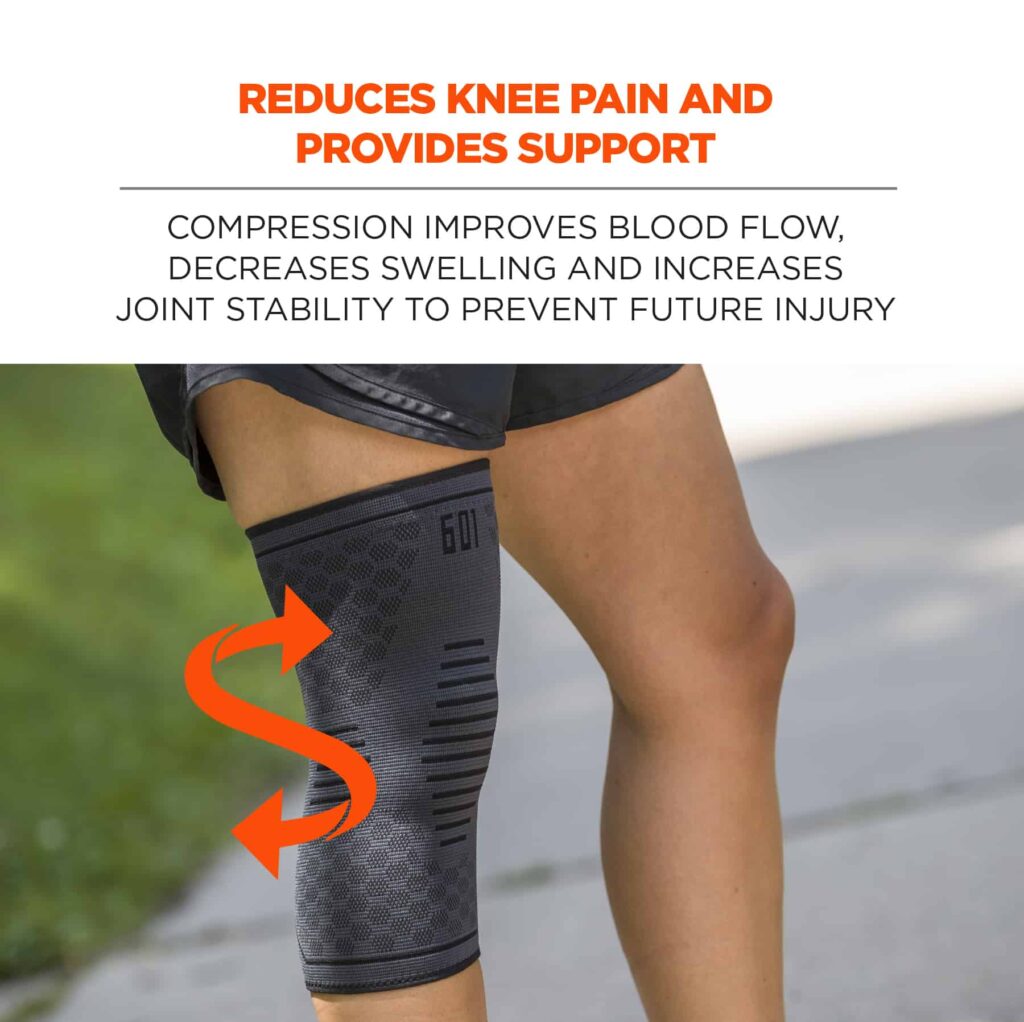A compression sleeve provides support and aids in improving blood circulation during physical activities. It helps reduce swelling and muscle fatigue.
Compression sleeves are popular among athletes for their benefits in enhancing performance and reducing the risk of injuries. By applying gentle pressure to the muscles, compression sleeves help stabilize and support them during exercise. This leads to improved blood flow, faster recovery, and reduced muscle soreness post-workout.
Beyond athletes, compression sleeves are also used by individuals with certain medical conditions like lymphedema or venous insufficiency. These sleeves offer a non-invasive way to manage symptoms and promote healing. Whether you’re an athlete seeking performance enhancement or someone managing a medical condition, a compression sleeve could be a beneficial addition to your routine.
Benefits Of Compression Sleeves
Compression sleeves are a popular choice among athletes and fitness enthusiasts for their numerous benefits. These snug and stretchy garments are designed to provide support, improve circulation, and reduce muscle soreness. In this section, we’ll delve into the specific advantages of wearing compression sleeves, including how they contribute to improving blood circulation and reducing muscle soreness.
Improving Blood Circulation
Compression sleeves work by applying gentle pressure to the limbs, which helps to improve blood circulation. The graduated compression provided by the sleeves helps to facilitate the movement of blood through the veins back to the heart, reducing the risk of developing blood clots and swelling. By enhancing blood flow, compression sleeves can also aid in the delivery of oxygen and nutrients to the muscles during physical activity, promoting better performance and faster recovery.
Reducing Muscle Soreness
Wearing compression sleeves can also assist in reducing muscle soreness and fatigue. The gentle compression helps to support the muscles and reduce the vibration and oscillation of muscle fibers during exercise, which can contribute to post-workout soreness. Additionally, compression sleeves can aid in the removal of lactic acid and other metabolic waste products from the muscles, helping to alleviate soreness and promote quicker recovery.

Credit: www.zensah.com
Compression Sleeves For Injury Prevention
Compression sleeves are essential for preventing injuries during physical activity. These sleeves help in stabilizing muscles and joints and reducing the risk of strains and sprains.
Stabilizing Muscles And Joints
Compression sleeves provide gentle pressure to muscles and joints, promoting proper alignment during movement.
Preventing Strains And Sprains
By offering support to the muscles and joints, compression sleeves help in preventing strains and sprains.
READ ALSO-Why Do They Cut the Net After a Basketball Game? Unveiling a Winning Tradition
Compression Sleeves For Enhanced Performance
Compression sleeves for enhanced performance are designed to optimize athletic performance by utilizing targeted compression technology. These sleeves are instrumental in improving various aspects of physical activity, leading to better overall results.
Increasing Oxygen Delivery
Compression sleeves enhance oxygen delivery to muscles, aiding in improved performance during physical activities.
Reducing Lactic Acid Buildup
By reducing lactic acid buildup, compression sleeves help athletes recover more quickly and perform better in subsequent sessions.
Choosing The Right Compression Sleeve
Compression sleeves are designed to provide support, improve circulation, and reduce swelling and muscle soreness. When choosing the right compression sleeve, it’s important to consider factors such as the compression level, size, and material. This article will explore essential aspects to consider when selecting the right compression sleeve to ensure maximum benefit and comfort.
Considering The Compression Level
Compression level plays a crucial role in the effectiveness of a compression sleeve. Different compression sleeves offer varying levels of pressure, typically measured in mmHg (millimeters of mercury). For mild support and daily wear, a lower compression level of 15-20 mmHg may be suitable. For more intense activities or recovery, higher compression levels of 20-30 mmHg or above may be more appropriate. Different activities and conditions may require different compression levels, so it’s essential to consult with a healthcare professional to determine the best level for your specific needs.
Selecting The Right Size
Choosing the correct size is vital to ensure the compression sleeve provides the intended benefits. Using a measuring tape, take precise measurements of the ankle, calf, and thigh circumference to determine the right size according to the manufacturer’s sizing chart. It’s crucial to follow the sizing instructions provided by the manufacturer to ensure a proper fit and effective compression. A compression sleeve that is too loose may not provide the desired support, while a sleeve that is too tight can cause discomfort and restrict circulation. Therefore, selecting the right size is crucial for maximizing the effectiveness of the compression sleeve and ensuring comfort during wear.
Tips For Using Compression Sleeves
Compression sleeves are not just accessories; they play an important role in enhancing athletic performance and promoting recovery. If you’ve recently started using compression sleeves or are considering incorporating them into your exercise routine, these tips will help you make the most out of your investment.
Wearing Them During Exercise
Using compression sleeves during exercise can provide numerous benefits, including improved blood circulation, reduced muscle fatigue, and increased joint stability. Here are a few tips to keep in mind when wearing compression sleeves during your workout:
- Choose the right size: Proper fit is crucial for effective compression. Ensure that your compression sleeves fit comfortably snug, but not too tight.
- Wear them before your workout: Putting on compression sleeves before starting your exercise routine helps warm up your muscles and prepares them for peak performance.
- Focus on targeted areas: Depending on your needs, you can choose compression sleeves that specifically target certain body parts, such as the calves, arms, or knees. Tailoring your choice to your target areas can maximize the benefits.
- Use them for recovery: Compression sleeves are beneficial not only during exercise but also for post-workout recovery. By wearing them after your workout, you can help reduce muscle soreness and promote faster recovery.
Taking Proper Care
To ensure the longevity and effectiveness of your compression sleeves, it’s important to take proper care of them. Here are some tips on maintaining your compression sleeves:
- Follow the manufacturer’s instructions: Different compression sleeves may have specific care instructions, so make sure to read and follow them accordingly. This will help prevent damage and maintain the compression efficacy.
- Wash them regularly: Regularly washing your compression sleeves helps remove dirt, sweat, and bacteria that can accumulate during exercise. Use a gentle detergent and follow the recommended washing instructions.
- Avoid excessive heat: High temperatures can negatively impact the elasticity and effectiveness of compression sleeves. Avoid using hot water or placing them near direct heat sources when drying.
- Store them properly: Proper storage is essential to prevent stretching or damage. Fold or roll your compression sleeves neatly and store them in a cool, dry place away from direct sunlight.
By following these tips, you can optimize your use of compression sleeves and enjoy their benefits both during and after your workouts. Remember to choose the right size, focus on targeted areas, and maintain proper care to ensure long-lasting effectiveness.

Credit: www.blog.ohmyarthritis.com

Credit: www.nike.com
Frequently Asked Questions For What Does A Compression Sleeve Do
What Are Compression Sleeves Used For?
Compression sleeves are commonly used to improve blood circulation, reduce swelling, and minimize muscle soreness. They can also provide support to muscles and joints, increasing stability during physical activity, and promoting faster recovery after workouts or injuries.
How Do Compression Sleeves Work?
Compression sleeves work by applying graduated pressure to the muscles, veins, and arteries in the targeted area. This compression helps to improve the flow of oxygen-rich blood, enhance lymphatic drainage, and reduce the build-up of lactic acid. It also provides support to the muscles, reducing the risk of muscle vibration and fatigue.
Can Compression Sleeves Prevent Injuries?
While compression sleeves can’t guarantee injury prevention, they can provide support and stability to muscles and joints, reducing the risk of certain injuries. By enhancing blood flow and minimizing muscle fatigue, they can help improve performance and reduce muscle imbalances, which may contribute to injury prevention.
However, it’s important to note that proper warm-up, cooldown, and overall fitness play crucial roles in preventing injuries as well.
Conclusion
Compression sleeves provide support and improve blood flow. They aid in reducing muscle soreness and fatigue during physical activities. With their versatile uses for various body parts, they help in injury prevention and promote faster recovery. Understanding the benefits, choosing the right compression sleeve is essential for maximizing its effectiveness.



